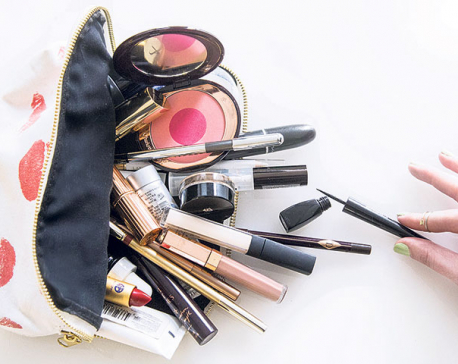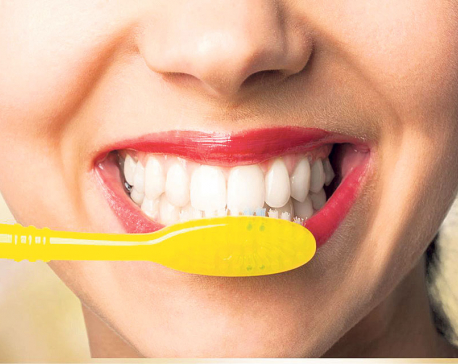
OR
BEAUTILICIOUS

Even before makeup experts begin picking cosmetic products to apply on their clients, there is an important factor that they consider: the client’s skin type. Makeup artist Binita Shah says that most of the time she can tell a client’s skin type while applying the primer. It’s something she has learned to do over the years. But if she is unsure, Shah says she makes it a point to ask as well because, as we mentioned, it’s that important.
 The nature of your skin doesn’t drastically alter makeup styles but they will require certain tweaks in the application techniques. The adjustments are subtle but they can make a big difference in the end. Shah helps The Week with her own experiences and tips.
The nature of your skin doesn’t drastically alter makeup styles but they will require certain tweaks in the application techniques. The adjustments are subtle but they can make a big difference in the end. Shah helps The Week with her own experiences and tips.
To begin with, one must recognize their skin type and its properties. This is crucial because, according to Shah, not being aware of this is the most common skincare mistake people make. If you are confused about your skin type and use the wrong products, over time, it can compromise your skin’s health and pH balance.
The same logic applies to makeup as well. If your skin type determines how you care for it, you should also choose your makeup base accordingly. This can make all the difference when you want to make sure your makeup is seamless as well as long lasting. Thus, the following tips have been given as per the different skin types.
Makeup for oily skin
Those with oily skin are known to have shiny, slightly greasy complexion with large, visible pores. Shah says it’s common for this type of skin to produce more sweat as well that obviously isn’t ideal for those who want to wear makeup. Further, it’s also common for the level of shine to increase around midday affecting your base products like foundations and primers.
So to combat these problems, Shah believes you have to choose specific products. Cream based makeup isn’t for oily skin. Compact might not be as effective as well. So your best resort here is loose power. They can cover your pores and absorb the excess oil.
These days, there are some companies that have come out with matte shine proof foundations as well as matte concealers and they perform exactly as they claim – helping you reduce the shiny, greasy look and minimizing the pores.
Shah also recommends finishing off the makeup with a setting spray. Since those with oily skin have more trouble keeping on the cosmetics for long hours, these sprays can help set their makeup.
Makeup for dry skin
Dry skin makes the face appear dull. The dullness can be more pronounced around the eyes, sometimes accentuating lines and wrinkles. Your pores will be barely visible but dry skins are more prone to appear rough.
Dry skin is basically caused by a lack of moisture in the corneous layer so Shah suggests you put extra emphasis on moisturizing before putting on your makeup. In fact, it’s best if you make it a part of your makeup routine. A couple of minutes before your put on your makeup, take a moisturizer specifically made for dry skin and take your time to massage it really well into your face and neck area. It’s a matter of necessity for you. So don’t skip the step. This will help your makeup process as well.
Drier skins that don’t break out have been known to handle heavier formulas pretty well. While oily and combination skin can’t deal with such makeup, as somebody with dry skin you have the option to play around with those.
But all in all, creamy moisturizing formulas works best for dry skin so go for the likes of tinted moisturizers that can add an extra layer of moisture, while also offering sheer coverage. Multi-use cream concealers also won’t cling to dry patches and emphasize flakes so they make for good options.
Makeup for combination skin
Combination skin is very common. This basically combines both the dry and oily skin types. The contrast is apparent on your T-zone (forehead, nose and at times, chin) that tends to be oily while the cheeks and other areas are dry. Those with combination skin have to deal with both large pores in oily regions and tight, flakey skin in the dry areas.
But as tricky as it sounds, taking care of and applying makeup on combination skin is pretty straightforward. It is all a matter of balance. You want to apply both tips that will absorb excess oil and fend off dryness. It will help if you use different products to target different areas. For instance, you will need to get started on a moisturizing regime for the dry regions of your face. However, at the same time, avoid using thicker creams on your T-zone. Instead, apply makeup setting spray around the area once you are done.
Some have even been known to use two different textures of foundation on combination skin. If the areas on your skin are very drastic, you can use oil free foundation on the T-zone and matte, moisturizing foundation on the cheek area. Just make sure the foundations are of the same shade.
Lastly, methodical cleansing before applying makeup and also when removing it are very important for this kind of skin as well as oily skin.
Makeup for mature skin
The nature of our skin tends to remain the same throughout the years but as we age, along with the general tips given above, we also have to consider the fine lines and wrinkles. While the right makeup technique can help camouflage it all, the wrong techniques will do nothing but highlight these issues.
So, for starters, those who have mature skin have to avoid heavy makeup. They will only accentuate lines and wrinkles making them more noticeable. Stick with light makeup and avoid heavy foundation.
Also steps like moisturizing and using primer become that much more important with age. If you plump up your skin with them prior to applying makeup, they will help the makeup glide better.
You May Like This

This happens to your skin when you don't remove make-up before sleeping
We have all been there, when we are too lazy to remove our make-up. From attending late-night weddings to a... Read More...

Makeup 101- what to put in your first makeup kit ?
From lotions and concealers to nail polishes and blush brushes, there exist a variety of tools that are essential in... Read More...

Everyday essentials: Six things you must do everyday to look your absolute best
Although beauty is quite subjective depending upon the preferences and taste of an individual, there are always small things that... Read More...




Just In
- Govt receives 1,658 proposals for startup loans; Minimum of 50 points required for eligibility
- Unified Socialist leader Sodari appointed Sudurpaschim CM
- One Nepali dies in UAE flood
- Madhesh Province CM Yadav expands cabinet
- 12-hour OPD service at Damauli Hospital from Thursday
- Lawmaker Dr Sharma provides Rs 2 million to children's hospital
- BFIs' lending to private sector increases by only 4.3 percent to Rs 5.087 trillion in first eight months of current FY
- NEPSE nosedives 19.56 points; daily turnover falls to Rs 2.09 billion















Leave A Comment